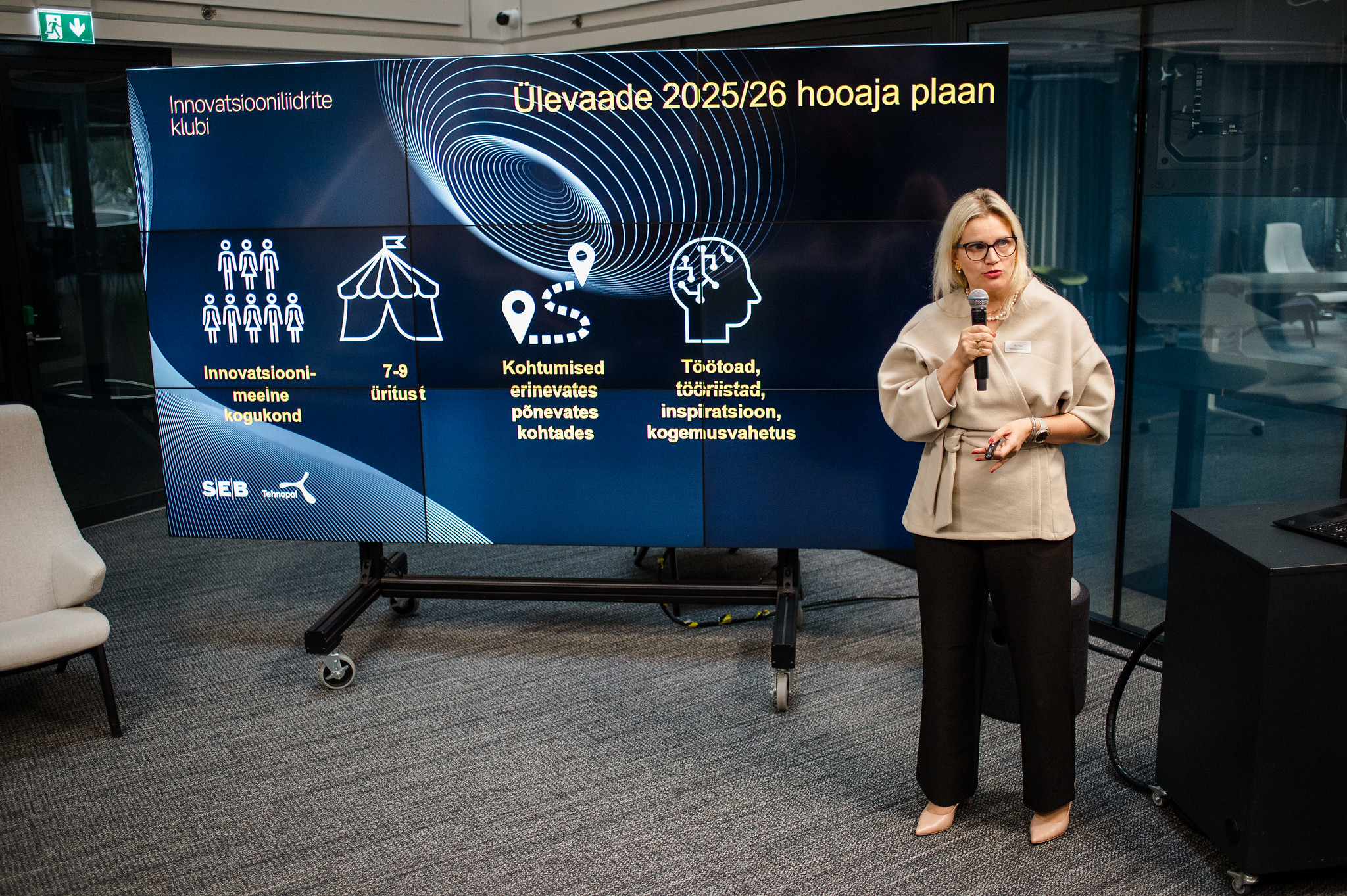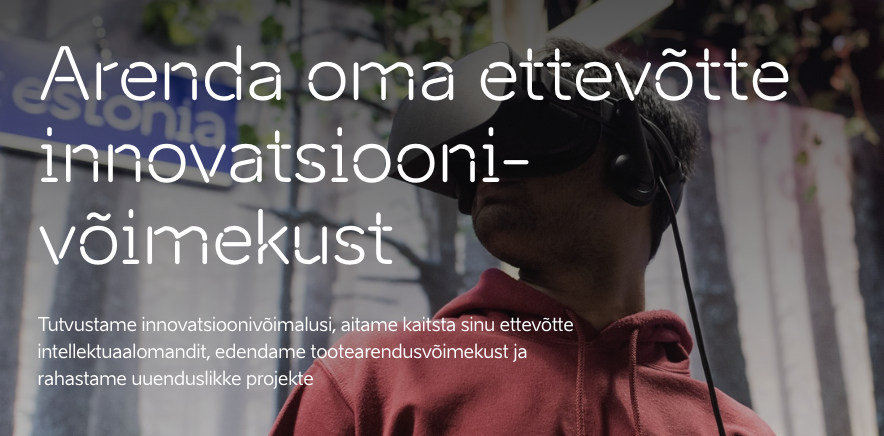Your guide to a more innovative company
Innosteps is a tool for increasing the innovation capacity of Estonian companies and developing a common culture of innovation.
Three steps to an innovative company
Read more about the processAnalyze and evaluate your company’s innovation capabilites
Create an individual action plan to increase your competitiveness
Use the opportunities of the Innosteps network to develop your business
Innosteps is a model for the development of the innovation capacity of companies, with the help of which we can talk about innovation based on the level of development and needs of each company.
The goal of innovation is to create new value for customers and achieve a competitive advantage that contributes to the growth of a company’s productivity. Innovations do not always have to be world-firsts or bring about radical change, but can also include small incremental improvements.
Registered users of the innosteps app have the opportunity to assess their innovation capacity with a simple test and find suitable partners for collaboration. The innosteps model is free for everyone to use.
192
Number of joined companies
Estonian companies interested in innovation, who contribute to the Estonian economy with their growth ambitions
2.1
Average score
The average Estonian company is just like this – shall we step on the next level together?
Innosteps matrix
The innosteps matrix addresses the six main factors of an organization’s innovation capability at five different levels. For a detailed description of each topic and level, click on the category!
Inspiration
Basic knowledge
Processes and organisational engagement
R&D and investment intensity
Global impact and reach
The company is keen to invest more in development alongside its current activities.
The company has the willingness to take new initiatives and the desire to better manage innovation processes.
Systematically managed innovation projects and the ambition to create an innovation strategy to promote, manage and implement innovation in your business.
The desire to make research and development an integral part of your innovation.
The research and development process forms the basis of innovation, helping to create new ideas, technologies, products, services or processes.
The company wants to create innovation projects with a long horizon to create market-changing products/services. Long-term innovation projects may include R&D activities to research and develop new technologies, long-term product development to conquer new markets or the creation of new business models that may change the company’s business model in the future.
Response to changes occurs as needed; innovation projects are not planned far in advance.
A targeted 1-2 year plan, ongoing development activities are budgeted, including innovation projects.
The company has a 2-5 year plan, which includes systematically managed innovation projects and targets. Innovation projects are planned and managed, following a defined methodology and system to ensure the successful development and implementation of innovation in the organisation in line with strategic objectives.
The company has a 5 to 10-year plan based on vision and knowledge-intensive innovation. Knowledge-intensive innovation requires extensive use and development of knowledge, expertise and intellectual capital. This implies that the successful implementation of innovation depends on a strong knowledge base and specialised skills.
The company has a 10+ development horizon and a strategy based on knowledge-intensive innovation. Knowledge-intensive innovation often involves research and development, where scientists, engineers and specialists develop new technologies, products or services.
The company has ambitions to be a market leader in the local market.
The company has the ambition to reach selected foreign markets with competition and has chosen specific target markets to match its product/service.
The company has a broader international market leadership ambition and the product/service sales ambition includes market leadership in its region.
The company has global ambitions to conquer markets. The company’s product/service sales ambition includes being a global market leader in its field.
The company has the ambition of a market-changing global collaboration platform and the goal of creating and launching a platform or solution that not only transforms an existing market or industry, but also supports international collaboration and influences global dynamics.
There is no international scalability or the focus is currently mainly on the domestic market. Enquiries from foreign clients are rather occasional.
Individual export markets where the product/service fits in. Regular orders from foreign customers, but no active sales to selected target markets.
The company has well-established international target markets and products/services to match them. Products/services are tailored to specific target markets. The company has export/sales managers and/or sales partners on the ground in the target markets with a focus on the target markets.
The company has a strong international brand and presence in foreign markets. It is expanding its reach into new markets. Products/services are developed specifically for different target markets. Exports account for a significant share of sales revenue
The company has global sales and business reach. Global scale of business refers to the company’s operations and expansion at an international level, where the company operates in several countries and/or in a large number of markets. The company engages in business activities that are internationally diversified and extensive.
There is no conscious effort to analyze work culture or create or develop a culture that supports innovation.
The company’s culture of innovation is not well established, but individual innovations can be tested.
A company culture that supports innovation, openness to change and willingness to take risks. The company invests in employee engagement, creativity, motivation and satisfaction. The company has a description of the recommended standards of behaviour and practices within the organisation. This includes the way in which people communicate, lead, collaborate and innovate.
A company’s innovation culture is based on shared values and beliefs. It is open to change and dares to take risks. The company has implemented innovation performance incentives to develop competences.
The company’s innovation culture is characterised by deep-rooted shared values and beliefs, while at the same time fostering creativity and efficiency through collaboration. A horizontal management culture is deliberately developed within the company. Open and honest communication is implemented, which contributes to an understanding of the culture and values of the organisation. The organisation’s core values and beliefs are actively promoted and emphasised.
Employees do not play an active role in innovation. Initiating and adapting to innovations is rather difficult, and employees value stability and daily work.
Individual innovation leaders who are open to change and willing to take risks. Innovation is pursued alongside their main work.
There are positions in the company whose tasks are related to innovation activities. Employees are motivated to think “outside the box” and carry the values of innovation.
The company has a competent team whose main tasks are related to innovation. They work with commitment, create and maintain a culture that supports innovation.
The company recruits in line with the objectives of the company’s innovation strategy, and consciously seeks people with values and skills that support innovation to complement our existing team.
Skills development is incomplete and haphazard. There has been no overview of the competencies required to participate in innovation activities.
The first competencies that employees need to successfully carry out innovation projects are defined. Training and workshops are organized, but on an irregular or project-based basis.
Employee competency development becomes continuous and systematic. Innovation development programs are implemented and employee skill development is regularly assessed.
Employee development plans are strategic and linked to the organization’s long-term innovation strategy. Skills development focuses on responding to market and technological changes.
Versatile competencies and skills for managing international projects, adhering to international standards, and creating global innovation networks.
The company’s technology is at the same level as its competitors in the market. It uses widely available technologies that are ready for use by all market players and do not provide a significant competitive advantage.
The company’s technology has some advantage in selected markets. The use of widely available technologies, adapted to the company’s processes, gives a competitive advantage in the target market.
The company’s technology gives it a significant advantage over competitors in its field. It makes significant use of upgraded technology, which gives it a competitive advantage in its field, irrespective of the region.
The company’s technology allows it to enter markets that are inaccessible to competitors. The use of novel and/or significantly upgraded technology gives the company a competitive advantage irrespective of the region and/or sector.
The company’s technology enables the creation of entirely new markets around the world. Unique technologies are used to create entirely new uses and to transform existing markets.
There is no clear and distinctive selling point. The business model is business as usual (similar to competitors). No experience of getting to know the customer/consumer and their real needs in order to adapt products/services accordingly.
The business model is constantly being rethought, and there are initial ideas and hypotheses on how the business model could be used to leverage competitive advantage in the future. Real changes to the business model have not yet been implemented. Competitive advantages could be price and efficient business processes. There are some innovative elements in the business model, but these are limited.
The business model is innovative at home and in selected target markets. Systematic renewal of the business model to maintain and/or completely change the current competitive advantage. The ambition is to achieve a clearly differentiated business model.
A business model that is significantly differentiated from its competitors, allowing it to exploit competitive advantages. Often a sector leader. The uniqueness of the company’s business model allows it to enter new markets.
We have a unique business model that has given us a first-to-market advantage. The company’s business model creates entirely new markets where it is the only or one of the few providers.
Product/service prevalent in the market. Competitive advantages are achieved through better pricing or more aggressive sales and marketing activities.
A market-enhanced product/service is a product or service that has undergone changes or improvements to better meet market demands or consumer expectations. This can include a variety of improvements such as increasing quality, adding features, changing design, adjusting price or improving service.
A distinctive own product is a product or service that is different from other similar products or services available on the market and offers unique characteristics, benefits or added value to consumers. This differentiation may include particular design, quality, features, brand awareness or other unique characteristics that make the product prominent and attractive on the market.
Internationally distinctive own product/service, recognised brand. The organisation makes consistent efforts to maintain and exploit the value of its brand and to ensure its effective protection and management. This can be an important part of business strategy and competitive advantage in the market.
An open innovation based proprietary product and/or service that is a leader in its product category. Open innovation is an approach where an organisation collaborates with external parties, such as other companies, universities, research institutions, customers or partners to identify, develop and implement new ideas and innovations. It involves sharing ideas and knowledge outside the company, and leveraging knowledge and skills from outside to create value and competitive advantage. Open innovation can include technology transfers, collaborative projects, licensing agreements and other forms of cooperation.
Business processes focus on key processes. Organic process improvement, mainly responsive to market conditions.
Some innovation in support and management processes, with the aim of making them more efficient. For example: an action plan for digitisation and automation has been established and partially implemented.
Deliberately implemented systematic digitisation and automation of business processes to achieve competitive advantage.
Innovation-driven systematic and proactive business process improvement and streamlining.
Systematic and strategic continuous business process innovation with performance evaluation.
The value proposition (trade secret, trademark, product/service) is not protected.
The knowledge necessary to realize the value proposition is kept as a trade secret, but the process is not documented. Trade secrets can cover various aspects, such as product/service quality, pricing formula, unique features, ease of use, brand reputation or customer service. Distinctive products/services are not protected by IO, the aim is to develop faster than competitors.
Partially protected trade secret and/or some registered intellectual property objects, but not yet a systematic approach. A protected trade secret is a trade secret consisting of information, data, processes or other specific knowledge that gives a company a competitive advantage because it is not publicly known. A protected trade secret can include a variety of information, such as product recipes, production processes, marketing strategies, customer lists, research and development results or other knowledge that is important to the company. The maintenance of trade secrets is documented and employees are informed of the relevant points in the employment contract.
The company has a portfolio of products protected by intellectual property rights. The intellectual property needed to realise the value proposition is catalogued and actively managed, and the protection of intellectual property through registration is systematised. The IPR portfolio comprises the company’s products, services or technologies that have been granted legal protection through intellectual property rights such as patents, trademarks, copyrights or designs. This protection helps the company to protect the intellectual property it has created and to ensure that no one else can use, copy or distribute it without permission.
The company has a well thought-out IP protection strategy, an actively managed IP portfolio and/or registered industrial property. An IP strategy is a company’s plan for how to protect the intellectual property it has created, such as patents, trademarks, copyrights, designs and trade secrets. The purpose of the protection strategy is to preserve and maximise the value of the intellectual property created, to protect it from unlawful use or misuse, and to give the company a competitive advantage in the marketplace.
There is no separate process for collecting ideas. New ideas are proposed randomly and their potential is assessed subjectively.
Ideation is driven by market demand and/or is largely related to process improvement. Employees have the opportunity to submit their ideas and improvement proposals. Ideation can involve various channels for submitting ideas, such as online platforms, hackathons, work meetings or ideation campaigns. Often, such ideas are aimed at solving individual, emerging problems or are improvement proposals submitted by customers.
Idea gathering to improve processes or products/services takes place at least once a year. From the ideas collected, a selection is made to be tested. Some market testing methodology is used.
The company has developed a regular open call for ideas. Ideas are systematically focused mainly on developing products/services and leveraging competitive advantage. A continuous market testing methodology is applied.
The presentation, validation and testing of ideas is continuous and based on open innovation. Idea collection is an integral part of the company’s innovation culture. There are extensive skills for market testing and risk assessment.
There is no in-depth knowledge or previous practice in managing development processes. Implementing ideas takes place outside of daily work. Prototyping and testing and validation of possible solutions are not carried out.
Innovation activities are need-based and are often related to improving existing products/services or process improvements. Experiments have also been carried out to develop individual new products and services. There is basic knowledge of design and prototyping but there is insufficient experience to test and validate the prototype.
Development activities are managed methodically. The design and/or prototype of solutions is validated at least based on the DFV model. The design phase checks whether the solution is useful or necessary and solves the problem (Desirability), whether the solution is technologically feasible (Feasability), and whether the solution is commercially profitable and sustainable (Viability).
The design and development process is methodical, holistic and systematic, covering the entire innovation portfolio across different innovation horizons. Collaboration is carried out with customers, partners and/or research institutions in both development and testing.
Development activities have become one of the core competencies. A significant amount of new knowledge, technologies and methodologies are used. Within the framework of open innovation, a diverse cooperation network is developed, which can include customers, partners, research institutions and various cooperation organizations.
Innovation projects are local. Process innovations are implemented on an ongoing basis alongside the main work. Product improvements are mainly related to individual changes. There are no own products/services.
There is basic knowledge of the methodology for bringing products/services to the market or implementing a new business model. Various methodologies are partly used in conjunction with the implementation of process improvements (Lean, Six Sigma, continuous improvement, etc.).
There is knowledge and experience in bringing products/services to market and basic knowledge of scaling methodologies. When bringing to market, it is considered that the product/service is ready for sale and marketing, use and after-sales service.
Successfully bringing innovation to market is the main goal of innovation projects. The company has established a solid methodology and process for bringing products/services to market. The ability to scale products/services to new markets and/or different market segments has been created.
Bringing to market and scaling capabilities are one of the company’s core competencies. Scalability is planned during the development of new products/services/business models. This is in the context of expanding and shaping the market, adding new segments, and adding new value.
Incremental improvements. There is no distinction between conventional improvement projects and innovation projects. Projects are undertaken where the risks are assessed or perceived to be low.
Innovations are handled on a project-by-project basis and/or as needed. Ideas are implemented in order of cognitive priority, with lower-risk projects being favored.
A comprehensive overview of innovation projects. A prioritization methodology suitable for the company has been developed, which, among other things, also includes an assessment of risk levels. Innovation and development projects are ranked based on the company’s goals and/or market demand. Projects can be divided both according to different risk levels and based on expected future business value.
Comprehensive portfolio management of innovation projects through the 3rd horizon. Projects are managed across different innovation horizons (1 – new to the company, i.e. incremental innovation; 2 – new to the target market and/or in one’s field; 3 – new globally, i.e. radical innovation). Comprehensive portfolio management ensures that one is prepared to address both short-term and long-term challenges and that innovation supports the overall strategy and business goals.
In addition to horizons and risk levels, innovation projects are also categorized into different segments according to specific goals, needs, or market characteristics (including customer segments). This allows you to focus on different areas in parallel and manage innovation resources more efficiently.
There is no conscious investment in innovation. Innovation activities are not differentiated in the budget.
The budget includes funds for innovation projects, but the costs of innovation activities are random, mainly responsive to market conditions, and the costs of innovation activities are not differentiated.
A fixed budget has been applied to innovation projects, including continuous automation and digitalization. Processes have been created to finance projects.
A significant portion of the budget is directed towards innovation. Investments are focused on research and development (approximately 2% of turnover or more than 1 million euros).
Financial planning is fully integrated with the innovation strategy, enabling industry leadership and direction setting. Investments are focused on research and development (approximately 10% or more of turnover or in millions of euros).
The capacity to raise money is currently lacking or inadequate.
Individual project-based funded innovation projects.
Systematic investments in innovation activities and the ability to consistently finance innovations.
Created a strategy for financing innovation projects and the ability to attract external investments and funding sources.
Broad and diverse sources of funding for innovation, including, for example, internal funds, venture capital and/or grant programs, and, if necessary, the ability to raise money by listing shares on the stock exchange.
The company is actively looking for partners for innovation projects and is not consciously sharing its knowledge with partners.
In its innovation activities, the company pays attention to collecting and sharing external and internal knowledge on a project or need-based basis.
The company has procedures in place to protect trade secrets/intellectual property, share its internal knowledge and skills, and utilize the knowledge and technologies of its partners.
The company has procedures and experience to create new knowledge or technologies in collaboration with other companies. The company is willing to license its knowledge and technologies to non-competing companies.
The company’s intellectual property based on open innovation is commercialized systematically, for example through licenses or the creation of spin-offs.
There is no cooperation with other companies or organizations related to innovation activities, but information is collected from the market regarding trends in the field.
To a small extent, innovation activities are carried out in collaboration with customers, partners and/or suppliers.
Established collaborative relationships and innovation projects with selected partners to develop new products and services.
Systematically functioning and continuous innovation partnership with companies, researchers, customers and professional networks.
Innovation cooperation operates through an open collaboration platform, through which the best market knowledge and collaboration partners are sought.
News
Exciting events and information take place in the Estonian innovation ecosystem. Stay up to date!



